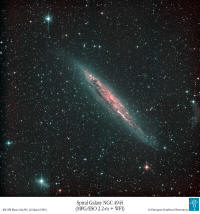|
AlienMind The Verdants
9. - A Mega-Population Problem Case
A Verdant told Krapf that the reversion to sexuality cost
them a significant part of their intellectual ability. If such is
the case, then why did they do so? For some strange reason, no
single Verdant explained their reasoning. The omission speaks
volumes about the larger Verdant outlook.
The two Magellenic Clouds and numerous smaller ellipticals complete the
picture. Moving counter clockwise as seen from above, the next
nearest galaxy groups (all similar in size to our group) are:
Sculptor, Maffei, M-81, and the Canes I
While interacting with the pre-noted human telepathic community, one advanced alien communicated an explicit map in such regard. Another advanced alien remarked that the Verdants have prematurely “cooked” M-83 by overusing electrogravity on a massive scale.
He suggested that, by doing so, the Verdants may
have caused certain supernovae in M-83 to explode prematurely, thus
decimating biological planets. When this last remark was stated,
there was a brief exchange between a Verdant and the alleging alien.
The allegation stood unchallenged. Again, this was observed by a
number of different humans.
To even be here, in our
vicinity tending to such matters from a distance can be risky. No
alien wants to be responsible for a Verdant seizure of their
technologies, which Verdants reportedly study and sometimes try to
copy. For example, a few years ago, Elder aliens specifically
reported a previous Verdant seizure of an Elder craft, the hull of
which was made of hybridized living materials that allowed it to
reconfigure in cold, empty space.
NGC 4945 (click image right) is a slightly larger spiral than is M-83. Meanwhile, the galaxy that clearly dominates spiral M-83’s galaxy group is Centaurus A, a much larger elliptical (nearly round) galaxy.
According to recent astronomers’ data, Centaurus A is the product of a merger between two large galaxies that was completed some 10 million years ago---before the present view, that is.
Centaurus A is some 12.4 million light years away from us.
Astronomers say the merger may have begun as much as 500 million
years ago. Some suggest that it is now a large elliptical with a
strange dust lane around its perimeter because it’s a large
elliptical that absorbed a modest spiral galaxy about the size of
our close neighbor galaxy, M-33.
According to
Phillip Krapf’s
report, the Verdants developed electrogravity technology some
229,000,000 years ago. Given that other advanced populations
probably existed near M-83 at the time, Verdants could have copied
electrogravity technology from such aliens, much as humans copied
downed gray alien technology more recently.
Had encroaching aliens taken unoccupied systems in M-83, the Verdants would have wondered whether Verdants would control their own fate or see their galaxy sped toward a habitable end in advance of its “normal” lifetime (due to Bearden’s *t, the speeding of time caused by the use of electrogravity).
Acting out of fear, Verdants may have been further motivated to
overpopulate and expand their domain in order to ward off further
incursions. Perhaps they saw that Centaurus A refugees
Hyper-novae caused by the merger of two star-sized black holes are the most violently explosive events yet observed within the universe. The hypernova that reportedly exploded in Centaurus A more than 10 million years ago probably involved black holes that contained millions of solar masses, hence the event was cataclysmic.
Given that two merging galaxies deform as they merge, causing some stars to plunge toward hot central regions of the new galaxy, the Centaurus A hypernova would have been alarming. If left unshielded, thousands of potentially habitable planets would have been rendered unlivable.
In fact, the Centaurus A hypernova suggests what may happen on a lesser scale during a future merger of black holes within M-83’s double center.
* M-83 is considered an “active galaxy” because it emits more
radio and infrared energy from its central active region, perhaps
due to its double center. M-83 is known for an unusual number of
supernova explosions.
Presumably, according to one NASA report issued several years ago, “life is ubiquitous” throughout the universe. Early life forms eventually evolve into higher intelligence in all habitable regions of all habitable galaxies. Given that the vast majority of visible stars lie within galaxy superclusters, it’s only logical to assume that supercluster social forms and supercluster constraints on overpopulation should, in theory, prevail across the universe.
In a sense, in much the same
way that New York and the world’s major population centers figure in
comparison to Waco, Texas, for example, superclusters should be more
challenging, yet more integrated and urbane than are outlying areas
like the Verdant galaxy group.
For example, according to Krapf’s figures taken from direct Verdant quotes, Verdants take 14 planets for themselves for every 1 occupied by another species in the IFSP. Worse yet, Verdants populate at 4 times the rate that all of the other IFSP (Intergalactic Federation of Sovereign Planets) populations do, on average, a dangerously unbalanced ratio.
Faced with a potential problem, it appears that a categorically more advanced population decided to steer Verdants outward as part of a strategy of eco-tensions - in part to give eco offenders reason to moderate, in part to show the Verdants as a teaching example of a failing ecology. There have been specific remarks by more advanced, “hyperversal” aliens to this effect (see later chapter about hyperversals).
Another hyperversal
alien faction that’s highly critical of the Verdants pointed out
that a Verdant-abetting hyperversal faction has gone out of its way
to find and identify emerging planets for the Verdants to target in
search of conscripts. After learning of this, I and other humans
probed and queried the Verdant-abetting hyperversal aliens, who
monitor the Verdants closely. They eventually admitted that Verdants
have, in fact, been steered toward planets like Earth.
According to Phillip Krapf’s remarkable journals, the Verdants are sexuals who are prone to territoriality and the sometimes clouded judgment that sexuality engenders. In this respect, as in most others, we see a subtler shading than is noted in humans.
Nonetheless, we can assume that some in the Verdant bureaucracy
suffer neurotic pitfalls that surround the circus-like manipulation
of lesser, off-world peoples. Due to the internal preoccupations of
their far-flung government, in times of crisis Verdant crews will be
pressured to conform to a colonial paradigm. As sometimes happens
within intelligent sub-cultures, the sexually-related weaknesses of
the Verdant elite can be flipped, in a sense, and come to be
regarded as positive attributes, rather than impulsive failings.
However, few Verdants will confess
that part of the breeding program seeks to infiltrate and gain
control over vital human sectors. In Krapf’s books, Verdants admit
having done that to other planets, and competing aliens allege that
Verdants are doing it here, also.
To stay on top, Verdants must be
coldly manipulative, especially during an intervention. In numerous
disputes with Verdants, I’ve noted this pattern repeatedly. For
example, when intruded upon personally, or when I note a violation
of humans in general, I sometimes probe and remotely test an entire
Verdant crew for details of their past and present intentions here.
This is done in flash-like bursts across a larger configuration
space (not in the sense of visible bursts) because it’s a
hyper-dynamic involving the negative cycle outlined in previous
pages.
Sometimes I even encounter non-sexual aliens whose intermediaries verge on masculinized characterizations, albeit infrequently. In particular, there is one hyper-advanced population of larger circulation that I refer to as the –X3’s, who, along with hybrid intermediaries, tend to the Verdant case in a variety of ways.
* More about the –X3’s and other “hyperversal” aliens in a
following chapter.
Native Milky Way and
other advanced aliens have repeatedly pointed out that part of the
given US family (the formerly Swiss branch: Biedermann) was “direct”
Verdant operative, possibly a result of the breeding program. The
news caused quite a stir, here, among the human community because it
corroborated a long-running pattern of thinly veiled verbal threats
to humans, a strategy of tension that such aliens have pursued for
years to the chagrin of a growing host of humans. As a result, there
have been sustained, finely networked efforts to probe the suspects
in such regard. The results have been disturbing, frankly.
Another reported “direct operative” is a noted
French financier named “Rothschild,” whose family first appeared on
a major scale by funding both Napoleon’s adventures and his British
opponents.
One
Verdant told Krapf that the Verdant IFSP inserted direct operatives
high into the social line-up on (at least) two other planets.
I’ll explain how this is done, in later pages.
Having done graduate study in US history, and having worked as an investigative reporter, I wouldn’t report the quotes unless they were:
Informative
alien mention was also made of a direct operative named “Gold,”
apparently a Jewish financial figure in New York City. A leading
Saudi family was also noted. It would appear that Verdants have a
multi-fold strategy for manipulating the human situation, at
present. They may be more ruthless than some might expect.
I’ve detected a subdued but droning kind of
lust for sexual adventure among the most coldly dysfunctional old
stalwarts. Apparently, some of the worst cases of the sort are
shipped out to work on the most distant, most primitive planets
targeted for colonization---like planet Earth, for example.
IFSP operatives must be
positioned to gain influence over organized crime structures on the
target planet, and breeding program operatives must be placed so
that they control the maximum amount of money and resources without
being exposed for their loyalty to the Verdant colonial scheme. To
some readers this surely sounds strange: corrupt aliens. To those
who know the history of colonialism, it should come as no surprise,
however. Humans aren’t the only kind that can do wrong.
Stark differences between crude Verdant colonial operatives and other, more finely-cultured Verdant specialists suggest that, like destructive cases of militarism on Earth, Verdants, too, have devised a stifled, if not infantile kind of citizenship.
To publish ugly details about their most aggressive
foreign policy failures would loosen the cohesion of the larger
empire. So, presumably, they glaze the cake - they overwhelm the
Verdant citizenry with more positive news and scientific reports
about their many planets.
This may be why
Verdants and
Grays have reportedly developed limited human-hybrid
offshoot colonies on several planets near our solar system,
ironically. Ultimately, to proceed at such effort and expense would
be costly, tempting Verdants to “mine” the vicinity’s resources in
order to profit by the interaction.
What single voice, what given Verdant planet would be sufficient to change the expansionist policy of so large and unwieldy a population? None, of course.
The most likely solution would be a collective security arrangement between all of the galaxy groups that surround the Verdant home group, an arrangement that should eventually include us.
Alternatively, the greatest chance for reform
of the Verdant empire may lie within a coalition of disparate,
non-Verdant planets who may try to democratize the Verdant-dominated
“federation” from within (even if they are a minority). There are
other, more advanced possibilities, including the largely veiled
interventions of hyper-advanced populations who greatly exceed the Verdants.
Were Verdant females to
control their government, it would probably be more ecological.
Nonetheless, in a lighter moment, one hyper-advanced
(non-federation) alien remarked that Verdant females are
characterized by an unusual “presence” of mind—a tongue-in-cheek
criticism of the more immediate, stimulus-seeking awareness that
sexuality engenders.
Assuming such numbers (essentially the only ones that we have to date) the largest reported mega-population in the Milky Way would occupy some ten or thirteen thousand planets, if the Verdant ratio of advanced aliens per planet holds true here, also.
In addition, we can assume that some more advanced
“hyperversal” aliens (part of a universal network of various hyperversals) reside within the Milky Way. They may interact with,
and at least partly constitute every major galaxy’s largest
coalitions. As such, the Milky Way would more closely approximate a
desired universal ecology.
* Note: In
late May 2004, one hyper-advanced alien mentioned that a neighboring
population of hyperversals (who I refer to as “the –X3’s”) is either
1.5 times as numerous as the Verdants, or some 1.5 quadrillion in
number—yet this last quote was so fleeting, albeit resonated
variously later, that it should be regarded as tenuous. There may be
more to the story. A later chapter discusses the –X3’s and other
“hyperversals.”
Phillip Krapf quotes one Verdant as saying that Verdants have tentatively occupied at least one planet in the Milky Way, which suggests that, in part, Verdants seek human affiliation in order to rubber stamp their expansionist policy. Human capitulation to such a scheme could put us at odds with native Milky Way and other aliens, if not cut us off altogether.
Why is that?
Consider the following.
|


